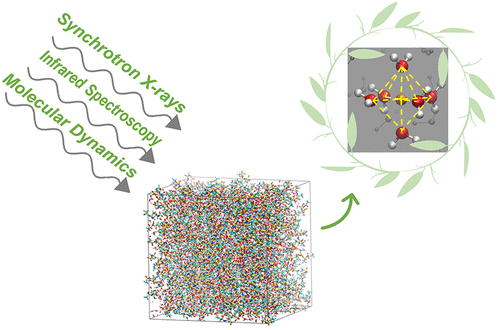当前位置:
X-MOL 学术
›
ACS Energy Lett.
›
论文详情
Our official English website, www.x-mol.net, welcomes your
feedback! (Note: you will need to create a separate account there.)
Water or Anion? Uncovering the Zn2+ Solvation Environment in Mixed Zn(TFSI)2 and LiTFSI Water-in-Salt Electrolytes
ACS Energy Letters ( IF 19.3 ) Pub Date : 2021-09-08 , DOI: 10.1021/acsenergylett.1c01624 Yong Zhang 1, 2 , Gang Wan 2, 3 , Nicholas H. C. Lewis 2, 4 , Julian Mars 2, 5 , Sharon E. Bone 3 , Hans-Georg Steinrück 6 , Maria R. Lukatskaya 7 , Nicholas J. Weadock 5 , Michal Bajdich 8 , Oleg Borodin 2, 9 , Andrei Tokmakoff 2, 4 , Michael F. Toney 2, 5 , Edward J. Maginn 1, 2
ACS Energy Letters ( IF 19.3 ) Pub Date : 2021-09-08 , DOI: 10.1021/acsenergylett.1c01624 Yong Zhang 1, 2 , Gang Wan 2, 3 , Nicholas H. C. Lewis 2, 4 , Julian Mars 2, 5 , Sharon E. Bone 3 , Hans-Georg Steinrück 6 , Maria R. Lukatskaya 7 , Nicholas J. Weadock 5 , Michal Bajdich 8 , Oleg Borodin 2, 9 , Andrei Tokmakoff 2, 4 , Michael F. Toney 2, 5 , Edward J. Maginn 1, 2
Affiliation

|
Applications of aqueous zinc batteries for grid-scale energy storage are limited by their poor reversibility and the competing water splitting reaction. The recent invention of a water-in-salt (WIS) electrolyte concept provides a new route enabling a stable and highly reversible aqueous zinc battery chemistry. In the present work, a mixed zinc bis(trifluoromethane sulfonyl)imide (Zn(TFSI)2) and LiTFSI WIS electrolyte was studied using X-ray total scattering, X-ray absorption, and Fourier transform infrared spectroscopy in conjunction with classical molecular dynamics simulations. It was found that, in the highly concentrated WIS electrolyte consisting of 1 m Zn(TFSI)2 and 20 m LiTFSI, Zn2+ cations are mainly solvated by six waters in their first solvation shell, while the TFSI– anions are completely excluded. This ion solvation picture is fundamentally different from the previous understandings. The results suggest that additional studies are needed to fully understand the unusual stability and reversibility of zinc-WIS electrolyte-based batteries.
中文翻译:

水还是阴离子?揭示混合 Zn(TFSI)2 和 LiTFSI 盐包水电解质中的 Zn2+ 溶剂化环境
水性锌电池在电网规模储能方面的应用受到其较差的可逆性和竞争性水分解反应的限制。最近发明的盐包水 (WIS) 电解质概念提供了一条新途径,可实现稳定且高度可逆的水性锌电池化学。在目前的工作中,使用 X 射线全散射、X 射线吸收和傅里叶变换红外光谱结合经典分子动力学研究了混合锌双(三氟甲烷磺酰基)亚胺(Zn(TFSI) 2)和 LiTFSI WIS 电解质模拟。结果表明,在由 1 m Zn(TFSI) 2和 20 m LiTFSI组成的高浓度 WIS 电解质中,Zn 2+阳离子主要在其第一个溶剂化壳中被六种水溶剂化,而 TFSI –阴离子则完全被排除在外。这种离子溶剂化图片与之前的理解有着根本的不同。结果表明,需要更多的研究来充分了解锌-WIS 电解质电池的异常稳定性和可逆性。
更新日期:2021-10-08
中文翻译:

水还是阴离子?揭示混合 Zn(TFSI)2 和 LiTFSI 盐包水电解质中的 Zn2+ 溶剂化环境
水性锌电池在电网规模储能方面的应用受到其较差的可逆性和竞争性水分解反应的限制。最近发明的盐包水 (WIS) 电解质概念提供了一条新途径,可实现稳定且高度可逆的水性锌电池化学。在目前的工作中,使用 X 射线全散射、X 射线吸收和傅里叶变换红外光谱结合经典分子动力学研究了混合锌双(三氟甲烷磺酰基)亚胺(Zn(TFSI) 2)和 LiTFSI WIS 电解质模拟。结果表明,在由 1 m Zn(TFSI) 2和 20 m LiTFSI组成的高浓度 WIS 电解质中,Zn 2+阳离子主要在其第一个溶剂化壳中被六种水溶剂化,而 TFSI –阴离子则完全被排除在外。这种离子溶剂化图片与之前的理解有着根本的不同。结果表明,需要更多的研究来充分了解锌-WIS 电解质电池的异常稳定性和可逆性。











































 京公网安备 11010802027423号
京公网安备 11010802027423号